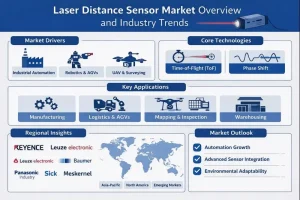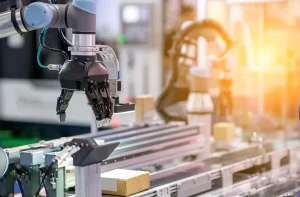Static vs Dynamic Laser Measurement: Ensuring Millimeter-Level Accuracy
When it comes to achieving millimeter-level accuracy in various industrial and scientific applications, understanding the differences between static and dynamic laser measurement is crucial. Both methods leverage laser technology to measure distances with remarkable precision, but their operational contexts, advantages, and challenges vary. One key component often used in static laser measurement systems is the static laser distance sensor, a device specifically designed for accuracy and stability under controlled conditions. This article delves into the core differences between static and dynamic laser measurements, examines the role of static laser distance sensors, and offers insights into selecting the right technology to ensure the highest accuracy possible.
What is Static Laser Measurement?
Static laser measurement involves capturing distance or dimensional data while the target or sensor remains stationary during the measurement process. In this method, a static laser distance sensor emits a focused laser beam that reflects back from the target surface, allowing precise calculation of the distance based on the time of flight or phase shift of the returned signal. Because both the sensor and the object are immobile, environmental factors and relative movement are minimized, making static measurements highly reliable and repeatable.
Key Advantages of Static Laser Distance Sensors
- High precision: Without the complications of motion, static measurements typically attain sub-millimeter accuracy.
- Stability: Sensors output consistent data over repeated measurements.
- Simplified data processing: Stationary measurement reduces noise, simplifying analysis.
- Ideal for calibration and quality control: Static measurement is perfect for applications that demand exact dimensions, such as component inspection in manufacturing lines.
Dynamic Laser Measurement: Measuring in Motion
In contrast, dynamic laser measurement systems capture distance data while either the sensor, the target, or both are moving. This method is essential in applications such as autonomous vehicles, robotics, and real-time process monitoring, where objects do not come to rest for measurement.
Dynamic systems often use scanning lasers, time-of-flight sensors, or LIDAR (Light Detection and Ranging) technology that continuously collect data points across moving surfaces. These measurements require advanced algorithms to compensate for motion-related distortions and ensure accuracy remains within acceptable limits.
Challenges in Dynamic Laser Measurement
- Motion-induced errors: Relative movement between sensor and target can introduce noise or measurement fluctuations.
- Complex data processing: Algorithms must correct for speed, angle, and environmental factors on the fly.
- Potentially lower precision: While still effective, dynamic measurements may not consistently reach the millimeter-level accuracy of static systems.
Static vs Dynamic Laser Measurement: When to Use Each Method
Choosing between static and dynamic laser measurement depends largely on the application requirements and context.
Situations Suited for Static Laser Distance Sensors
- Manufacturing quality control: Verifying component dimensions with utmost accuracy.
- Structural health monitoring: Measuring static deformation or cracks in materials.
- Laboratory research: Experiments requiring stable, repeatable distance measurements.
- Calibration: Reference distance measurements for other instruments or systems.
The static laser distance sensor excels where minimizing environmental variation and motion is possible.
When Dynamic Measurement is Preferred
- Autonomous navigation: Real-time obstacle detection on moving vehicles.
- Robotic arms and automation: Measuring surfaces during continuous motion.
- Industrial process control: Monitoring materials on conveyor belts or moving machinery.
- Large-scale surveying: Mapping environments where stationary positioning is impractical.
In dynamic scenarios, the focus is on data acquisition speed and processing rather than absolute precision.
Ensuring Millimeter-Level Accuracy: Tips for Optimal Results
Regardless of the measurement mode, certain best practices help guarantee millimeter-level accuracy.
For Static Systems
- Use high-quality static laser distance sensors: Opt for sensors with verified precision specifications and stability.
- Maintain sensor alignment: Proper orientation reduces angular measurement errors.
- Control environmental conditions: Temperature, vibration, and dust can affect readings.
- Calibrate regularly: Periodic calibration against known standards ensures consistent performance.
For Dynamic Systems
- Apply motion compensation algorithms: Sophisticated software can correct for speed and angle variations.
- Optimize sensor placement: Position sensors to minimize relative velocity or angular discrepancies.
- Employ multi-sensor fusion: Combining data from several sensors enhances overall accuracy.
- Leverage real-time data filtering: Filtering techniques reduce noise and false readings.
Future Trends in Laser Measurement Technology
Advances in laser technology continue to improve both static and dynamic measurement capabilities. Innovations such as ultra-fast laser pulse systems, improved sensor miniaturization, and AI-driven data processing are pushing the boundaries of accuracy and speed.
Hybrid systems that combine static measurements for calibration with dynamic scanning during operation may emerge as a new standard to ensure both precision and flexibility.
Conclusion
Understanding the fundamental differences between static and dynamic laser measurement techniques is essential for applications demanding millimeter-level accuracy. While static laser distance sensors provide unmatched precision under controlled, stationary conditions, dynamic systems offer the versatility necessary for real-world moving environments. Selecting the right approach—and following best practices in sensor use and data processing—ensures that your measurements remain accurate, reliable, and fit for purpose. Whether in manufacturing, robotics, or surveying, leveraging the appropriate laser measurement method can drastically improve the quality and efficiency of your operations.




